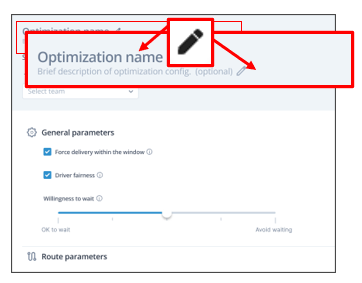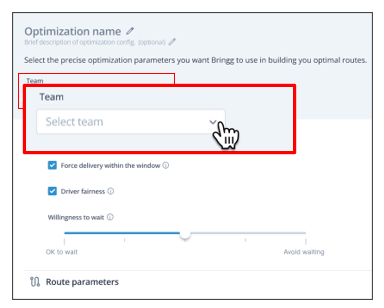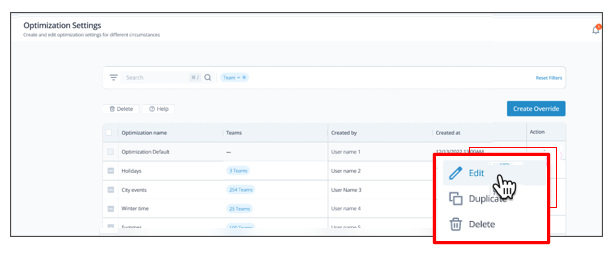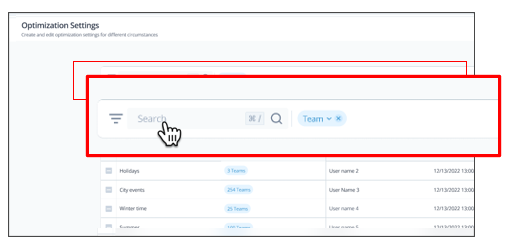Once you have finalized your default optimization parameters for planned deliveries in Bringg, you can create override settings that apply to specific teams or circumstances.
For example, set a wider maximum radius for teams working in more expansive rural areas, or create a set of optimizations with different traffic or route considerations to account for minimal resources amidst higher demand during the holiday season.
You can choose to duplicate existing optimization settings to make small variations, or create an entirely new set of configurations.
Before You Begin
- Confirm you have a user account of type Admin.
- Confirm your Bringg account uses the required optimization engine.
- Work with your colleagues to develop a list of the various optimization scenarios for your company's use cases.
- Contact your Bringg customer service representative to set up the initial optimization settings. Learn more.
- Verify your default route optimization settings. Learn more.
- Define the shifts and allocation of resources, by creating delivery blocks. Learn more.
- Set up your delivery options with delivery slots. Learn more.
- (Optional) Give the RO engine more vehicle details by configuring vehicle profiles and assigning them to your vehicles. Learn more.
Procedure
Step 1: Access the configuration settings page by selecting your username > Settings > Optimization Settings.
.png) Access the optimization settings
Access the optimization settings
Step 2: Open a new page of optimization settings.
To override the default settings for particular circumstances or teams, select Create Optimization Policy from the optimization settings summary menu.
Step 3: Distinguish the new optimization set from others by editing the name and description.
 Name the optimization override setting
Name the optimization override setting
Step 4: Select the teams to whom you want to assign these settings.
 Assign teams to apply this optimization
Assign teams to apply this optimization
Step 5: Adjust the settings as needed.
For example, to save unforeseen costs, you can set your optimization to avoid toll roads.
| Field | Description |
|---|---|
| Maintain consistency | When enabled, the optimization preserves a consistent solution each time using the same priorities. Otherwise, it may offer you alternative optimal solutions, prioritizing different elements, to help you find the one that best suits your priorities. |
| Driver fairness | If enabled, this setting ensures equitable distribution among drivers with respect to the duration of each route (including ETOS). In this case, the optimization selects the route with the lowest standard deviation among drivers for the total route time, but does not consider whether the number or orders assigned to each one is distributed equitably. |
| Use all drivers | If enabled, the optimization will prioritize assigning orders to all the drivers who are on shift and available instead of creating fewer routes with fewer drivers. |
| Limit absolute orders on route | When enabled, the optimization engine understands the maximum number of orders allowed on a route as the total number allowed, not just the maximum allowed at any point along the route. For example, when a driver is contracted based on a maximum number of orders they can deliver on a route or shift. |
| Consider capacity limitations | When enabled, the optimization considers the maximum handling units and weight capacity that the vehicle can transport at a time. |
| Max. order radius | The aerial distance limit (km) of any route from the driver start location. The optimization excludes any order outside this radius. |
| Force earliest departure | When enabled, the optimization requires drivers to begin routes at the earliest time they are available, whether or not this will cause waiting time later on. Note This setting may override Willingness to wait for the first stop on a route. |
| Force delivery within the time window | Selecting this option means the ETA and estimated time on site (TOS) of an order's fulfillment cannot extend beyond the order's time window. For example, if an order that requires assembly has an ETOS of 30 minutes, RO will exclude it from a route if it will arrive within a half hour of the end of the time window. |
| Max. route distance | The maximum distance (km) that the optimization can assign to a route. |
| Initial loading/unloading time (minutes) | The standard time (minutes) the optimization adds to the start or end of a delivery block to account for either loading or unloading the vehicle. |
| Squash time (minutes) | The time (minutes) added for every order after the first one, which is delivered to the same address and customer as the first. For example, if you are sending two orders to Customer X, each with an independent estimated time on site (ETOS) of 15 minutes, and a squash time of 5 minutes, the total ETOS for both orders together is now 20 minutes instead of 30. This setting does not consider differences in order type, such as time required for pick up time as opposed to drop off. Note This setting does not consider differences in order type, such as time required for pick up time as opposed to drop off. |
| Exclude ferries | When enabled, the optimization will exclude routes requiring transport via ferry. Use to avoid delays due to congestion at docks. |
| Exclude alleys | When enabled, the optimization will not propose routes requiring travel through alleys. Recommended if you use larger vehicles. |
| Avoid toll roads | (Outside USA only) Indicate whether or not you want the optimization to avoid toll roads and thereby save costs. In the USA, this setting is automatically required. |
| When rerunning optimization: Preserve sequence or Reshuffle | Select which method to use when adding new orders to an already optimized route:
|
| Willingness to wait | For stops along a route, indicate using the slider scale to what extent it is an issue for a driver to arrive ahead of schedule and need to wait before fulfilling the order. This setting is not considered by the optimization on the first stop, especially when Force earliest departure is enabled. Note Apply this setting only when all orders in the route have the same time window. For example, if they all must be delivered on Tuesday between 8:00-17:00. |
| Default clustering level | The default rank you set for the route clustering process. A higher rank means less often that drivers will crisscross with one another during a shift. |
| Default start/end location | Select which option from the dropdown menu to set as the default start or end location of your routes. |
| Traffic variable | (Default traffic) The percent of added time to the route due to anticipated traffic. For example, set a +50% anticipated traffic delay in the morning and evening throughout the week and a +125% delay on the day of a major town event that involves road closures. Note Not applicable when using advanced traffic integration, or when traffic variables are applied to specific service areas. Learn more. |
| Allow flexible reloading | Selecting this option gives drivers permission to complete multiple routes in one day by returning to the fulfillment center to pick up more orders. Reloads depend on capacity limitations. If preset reload times are already defined in delivery blocks, this setting allows for additional reloads. |
Step 6: Preserve or erase your configuration by selecting Save or Discard.
.png) Choose whether to save your settings
Choose whether to save your settingsStep 7: (Optional) Adjust saved optimization sets to adapt to changes in your business goals. From the optimization settings summary menu, select the horizontal menu > Edit in the default setting's listing.
> Edit in the default setting's listing.
For example, you may need to increase the default clustering level if you want each of your drivers to stay focused in their own geographic areas.

For example, find all the optimization sets assigned to a particular team.
